The Desktop Kabini Review Part 1: AMD Athlon 5350 (AM1) Tested
by Ian Cutress on April 9, 2014 8:00 AM ESTIGP Comparison, Synthetics
AMD’s graphics stack from top to bottom is all based on the Graphics Core Next architecture. This is an update from earlier VLIW implementations, offering for scalability from low power all the way up to high performance. At the heart of an AMD graphics system is the compute unit comprising of 64 GPU cores. Each compute unit can act independently, ensuring that multiple tasks can complete as quickly as possible due to multiple kernel dispatch across the entire core. In the Kaveri APU launch we were dealing with APUs that contained 6 or 8 compute units for 384/512 cores. With this level of performance, gaming at 1080p30 was possible on most titles depending on how the quality settings were configured. For Kabini, the entire range is given two compute units, with individual processors differing in clock speed.
With two compute units, we are not expecting much from the gaming aspect of these APUs in terms of ‘the latest’ titles. Our benchmarks in the next few pages show that even F1 2013 at 1280x1024 on low settings, unless the engine powering the game is basic, 25 FPS minimum is a hopeful target. This lack of horsepower may limit these APUs to Flash based titles, perhaps even some of the more reasonable Unity games. In AMD’s slide deck they quote games such as Minecraft, Lego Marvel Superheroes and Bastion as the sort of titles that a Kabini player should aim for.
There is some confusion regarding the naming convention of these integrated graphics solutions. Soldered on Kaveri parts designed for all-in-ones, such as the A6-5200, use the HD8000 naming scheme, such as the HD8400. The Athlon 5350 is analogous in design to the A6-5200 except for a 50 MHz speed bump and the name of the IGP – here this is designated as the R3 series. This is despite retailers who are currently selling this APUs and labeling them with the HD8000 designations.
Like Kaveri, the integrated graphics solution in Kabini features an updated Video Codec Engine and Unified Video Decoder giving hardware support for H.264.
AMD is also promoting their Picture Perfect solution, using additional post processing tools to increase video quality on the fly:
Also rather interestingly AMD is claiming an enhanced decoder for JPEG files. Given that one of the primary uses for a Kabini system might be for web access where JPEGs are standard, AMD has been promoting up to a 2x performance increase over a J2900 system:
AMD’s secret sauce, according to their slides, appears to be heterogeneous computing. This would be the ideal usage scenario for computing going forward.
GPU Synthetics
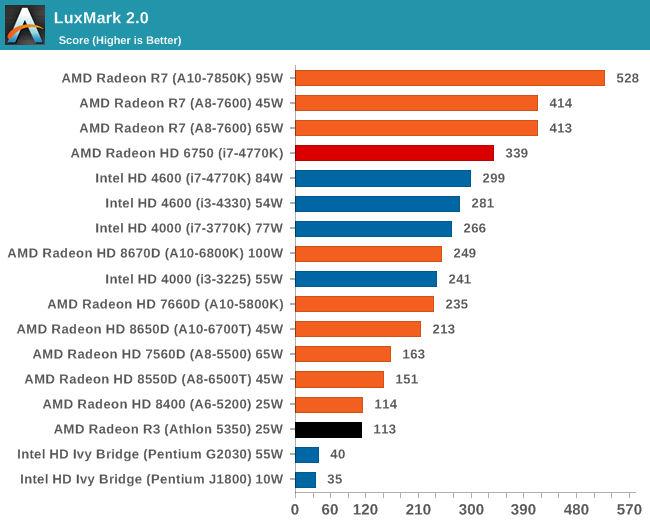
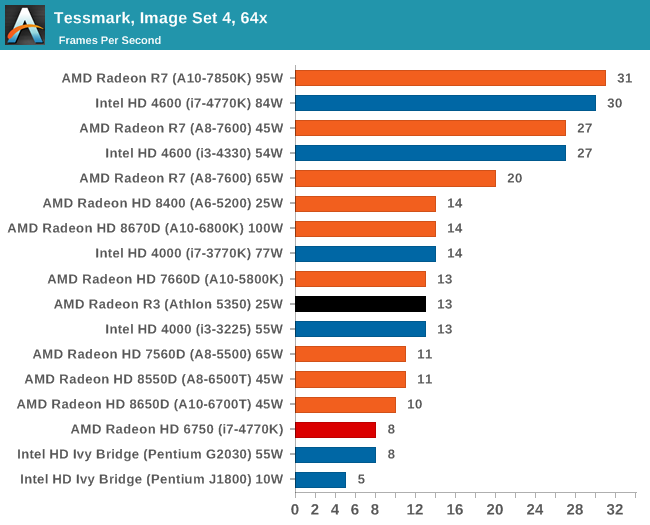


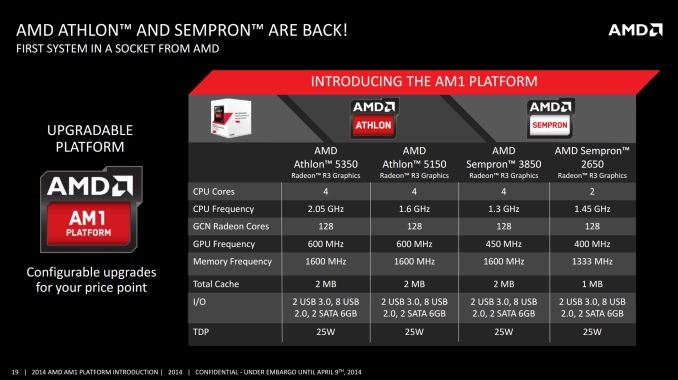
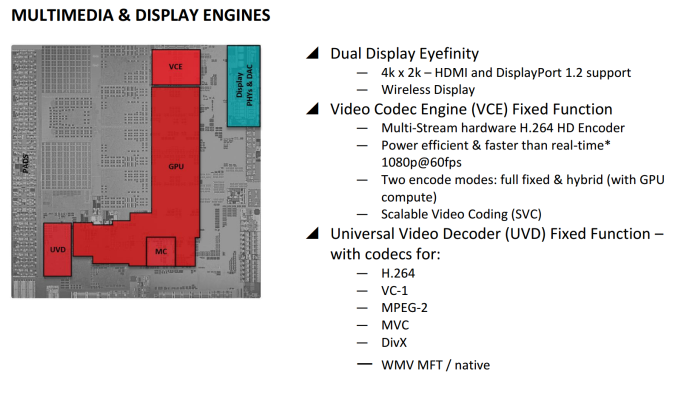
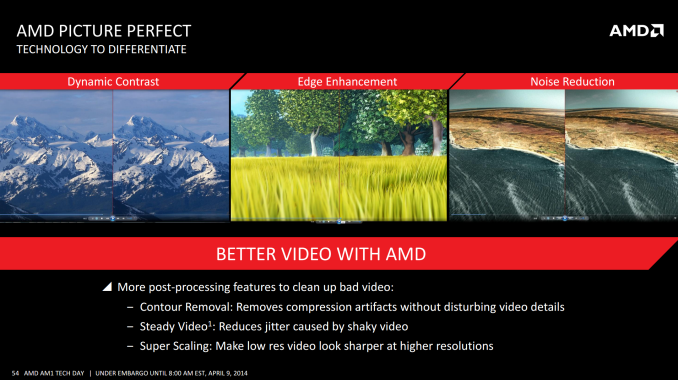
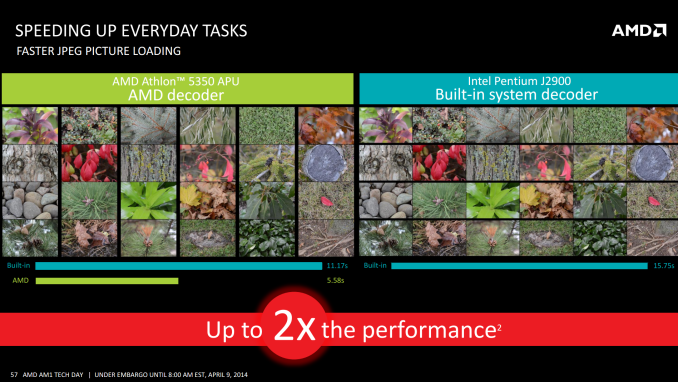
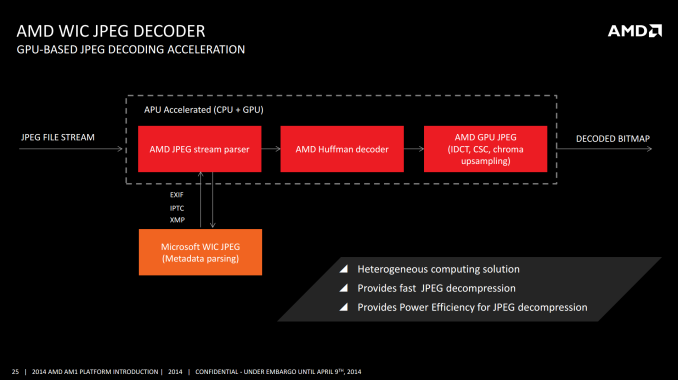








126 Comments
View All Comments
ozzuneoj86 - Wednesday, April 9, 2014 - link
I do hope that all of this works out for AMD. It seems like a pretty huge gamble to invest so much time and energy into creating a new socketed platform. I do like the idea of tiny yet powerful systems, for sure. I built a Pentium 4 based mini-ITX system that won Maximum PC's rig of the month in July 2007, since there were relatively few ITX systems available at the time. This was pre-Atom, so you were either spending $300+ on a board that took an equally expensive Core-based laptop CPU, or you were going with a Via C7 or some other abysmally slow chip built into a board that still cost $200. Our grand total for the whole project was under $500.That system is socketed, but with Intel Extreme 2 graphics (before GMA) and only a PCI slot to work with, there was only so much it could be used for. It handles emulators perfectly fine though.
Anyway, I just hope they hang on to this platform for a while so that it makes sense for it to be socketed. Looking at the CPU options available, it doesn't look like it offers a huge range of possibilities. They are all quite firmly seated in the low end of performance and aren't all that power efficient. I could see a low end platform being useful if they offered significantly different combinations of CPU power, GPU power and wattages, but I'm not really seeing that with these.
ozzuneoj86 - Wednesday, April 9, 2014 - link
For clarification, by "not all that power efficient" I mean the TDP, when compared to Intel's non-socketed chips. These are still fairly low wattage, but you can't exactly stuff one of these in a cigar box and run in passively cooled.Also, any chance we could get a Celeron 1037u system benchmarked as well? I'm curious as to how the CPU\GPU performance compares to the J series, as well as Kabini. http://ark.intel.com/products/71995
Hardened - Thursday, April 10, 2014 - link
I woul like to support request for comparison with Celeron 1037U. It is a very interesting CPU performance and cost wise. Gigabyte GA-1037UN mobo is also a very nice offer with 2x LAN and eSATA ports all under 90 USD.Computer Bottleneck - Wednesday, April 9, 2014 - link
Do we know if any manufacturers will be supporting ECC RAM on these boards? Or any upcoming AM1 boards?According to CPU World Athlon 5350 does indeed support ECC:
http://www.cpu-world.com/CPUs/Jaguar/AMD-Athlon%20...
TheCrustyCupcake - Wednesday, April 9, 2014 - link
Water cooled AM1 socket-ed APU's anyone? If overclocking was available I could see an EVGA super ultra FTW edition AM1 motherboard with an 8-pin supplemental CPU power connector, and crossfire support!DudemanX - Wednesday, April 9, 2014 - link
In part 2 and in future articles when reviewing IGPs, can you do some game benchmarks at more mainstream resolutions(1680, 1920, maybe even 1440) but with "Low" quality settings? Many might disagree but not running my display at native resolution is one of the last compromises I make when using inadequate hardware. I understand these aren't mainstream chips but they are desktop/media center chips. Do people really buy desktop monitors/TVs lower than 1680 these days? Certainly no one's running games in 4:3 anymore, are they?mariush - Wednesday, April 9, 2014 - link
I just don't understand why they don't make the boards for these systems to run on 12-19v laptop adapter type power supplies.It's really not that expensive to add a dc-dc converter on the motherboard to make 5v for the sata drives and onboard stuff... no, we still have to use a big fat 24pin atx cable AND a 4 pin cpu cable for a system that uses 30-60 watts (without a powerful video card).
srkelley - Wednesday, April 9, 2014 - link
Can you post some modified benchmarks of the gaming performance please? I'm interested in seeing the average frame rate of the same games but run with Medium settings at 1280x720 please. It doesn't need to be in a fancy chart or done completely scientifically, just a few numbers would be helpful!shady28 - Thursday, April 10, 2014 - link
Great review, this helps clear up some questions regarding AM1.Suggestion for your follow up -
If possible, show more of the chips this succeeds and that it competes against.
ie :
J1800, J1900, 3770, and some of the older Atoms like D525 or D510.
It would also be interesting to see a couple of older reference desktop, like a P4 D chip. For some this would help answer the question, is this a viable upgrade for someone who wants a small low power replacement for an old power hog of a P4?
The obligatory i5-2500k or i5-3570k is fine, but stacking up a huge number of 100W chips in the comparison doesn't help, it just clutters up the charts with products that in no way compete with something like Kabini.
Penti - Thursday, April 10, 2014 - link
So it's a Kabini/Jaguar fabbed at Global Foundries in Germany? Why?